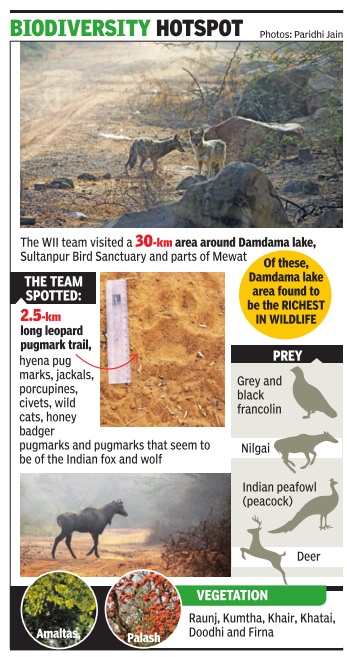Aravali range
m (Pdewan moved page Aravalis, Lake, Damdama to Aravalis: India without leaving a redirect) |
Revision as of 00:38, 27 February 2016
This is a collection of articles archived for the excellence of their content. Readers will be able to edit existing articles and post new articles directly |
Aravalis, Lake, Damdama: Aravali’s Last Lake in Danger
Haryana to allow houses on hillock next to Damdama Any structure on the hill will block flow of rainwater, thereby endangering the future of the water body Dipak Kumar Dash | TNN
Damdama (Gurgaon): Another lake in the Aravalis may soon be consigned to oblivion. If Surajkund and Badhkal lakes succumbed to mining activities in the Aravalis, Damdama, the last surviving water body in the region, may also go dry thanks to the government’s short-sighted policy that will soon facilitate construction in the area.
The revenue department in Gurgaon has almost completed the consolidation (Chakbandi) of plots on a hillock — Roj Ka Gujjar — spread over 5,744 acres adjacent to the lake. This will allow owners to construct houses on their plots. And any structure on the hillock, say environmentalists, will obstruct smooth flow of rainwater, the only source of replenishment, to the lake, almost 40 km from the national capital.
‘‘Any activity in the region will mean that the flow of rainwater to the lake will stop or would be adversely affected. Moreover, people will end up extracting groundwater, which is equally damaging,’’ said R P Balwan, former conservator of forest of southern circle (Gurgaon).
Originally, the hill was commonly owned by residents of 12 villages in the region. ‘‘But almost 90% of the land on the hill has already been sold to outsiders, mostly from Delhi. This had been happening since 1980s. The original owners have sold their shares, though those were not identified. After the consolidation, plots will be demarcated and given to the new individual owners. Those who have bought land are rich and influential people,’’ said a revenue department official.
However, he added that when the department was about to notify consolidation, a scam was detected and the process was put on hold. ‘‘We found that the total land sold was more than the actual area of Roj Ka Gujjar. An additional 631 acres had been sold. The regional commissioner has ordered us to halt the process of handing over of the plots,’’ he added.
The list of discrepancies doesn’t end there. The Ministry of Environment and Forest (MoEF) had written to Haryana government in December 1992 mentioning that all the areas notified under Punjab Land Preservation Act (PLPA) are forests and such areas cannot be used for non-forestry activities without prior permission from the ministry. Though Roj Ka Gujjar is covered under PLPA, its land is now up for consolidation.
Balwan said that construction of any dwelling unit, road or path, electricity poles has also been prohibited. Moreover, the hillock was also covered under Aravali plantation, which has been declared as deemed forest by the Supreme Court. ‘‘The revenue department should not have allowed the sale and purchase of common land since it was not demarcated or fragmented,’’ he added.
But, people who have bought land adjoining the half-dry waterbed of Damdama have started constructing boundary walls. ‘‘In the last few years, more people have bought land around the lake. Things would get worse when more people will occupy the hilltop,’’ cautions Bane Singh, a resident of Damdama village.
Sources said that the revenue department wants to ensure that the drains and streams, which carry rainwater to the lake, are not blocked. ‘‘We have included this in the consolidation scheme so that the natural water supply to the lake is not disturbed. Though consolidation would be finalised soon, land owners would have to get approval for anything they do on their land,’’ said a senior revenue department official.
February 2016: Plan to protect Aravalis in Haryana
The Times of India, Feb 05 2016

Wildlife study to find focus spots
Jayashree Nandi
A study by the Wildlife Institute of India (WII) will soon point out “potential“ wildlife areas in the Aravalis in Haryana that require special conservation measures and protection from urbanisation. The Haryana forest department had commissioned WII to carry out a survey to identify vulnerable areas that needed government intervention. The Aravali range ends in Haryana and is, therefore, an ecologically fragile region that is threatened by modernity . Unlike in Rajasthan, which has a number of protected areas, including the Sariska National Park, the wildlife-rich areas of Haryana had never been identified. “The forest department wants to have a document at hand to be able to resist any pressure to change land use,“ said Bilal Habib of the animal ecology and conservation biology department at WII.
The WII team comprising project biologists Anchal Bhasin and Paridhi Jain, along with local villagers, have finished scouting a 30-km area around Damdama lake, Sultanpur Bird Sanctuary and parts of Mewat in the past month or so.They found ample evidence of wildlife, particularly around Damdama lake, including a 2.5-km-long trail of leopard pugmarks. They also noticed hyena pugmarks and some unidentified pugmarks that could be of the Indian fox.
Despite the presence of tigers in the Rajasthan Aravalis, the WII team isn't quite hopeful of finding the big cats on the Haryana side because the habitat is quite degraded. “There is too much human presence and disturbance for tigers to be living here. Tigers also don't prefer undulating terrain as habitats,“ explained Bhasin.She said that if it could be confirmed that the Indian fox could indeed be found here, it would be an important discovery .Indicators of leopard presence are, of course, the most important discovery because it means there are many other smal ler animals living there on which the spotted cats prey .